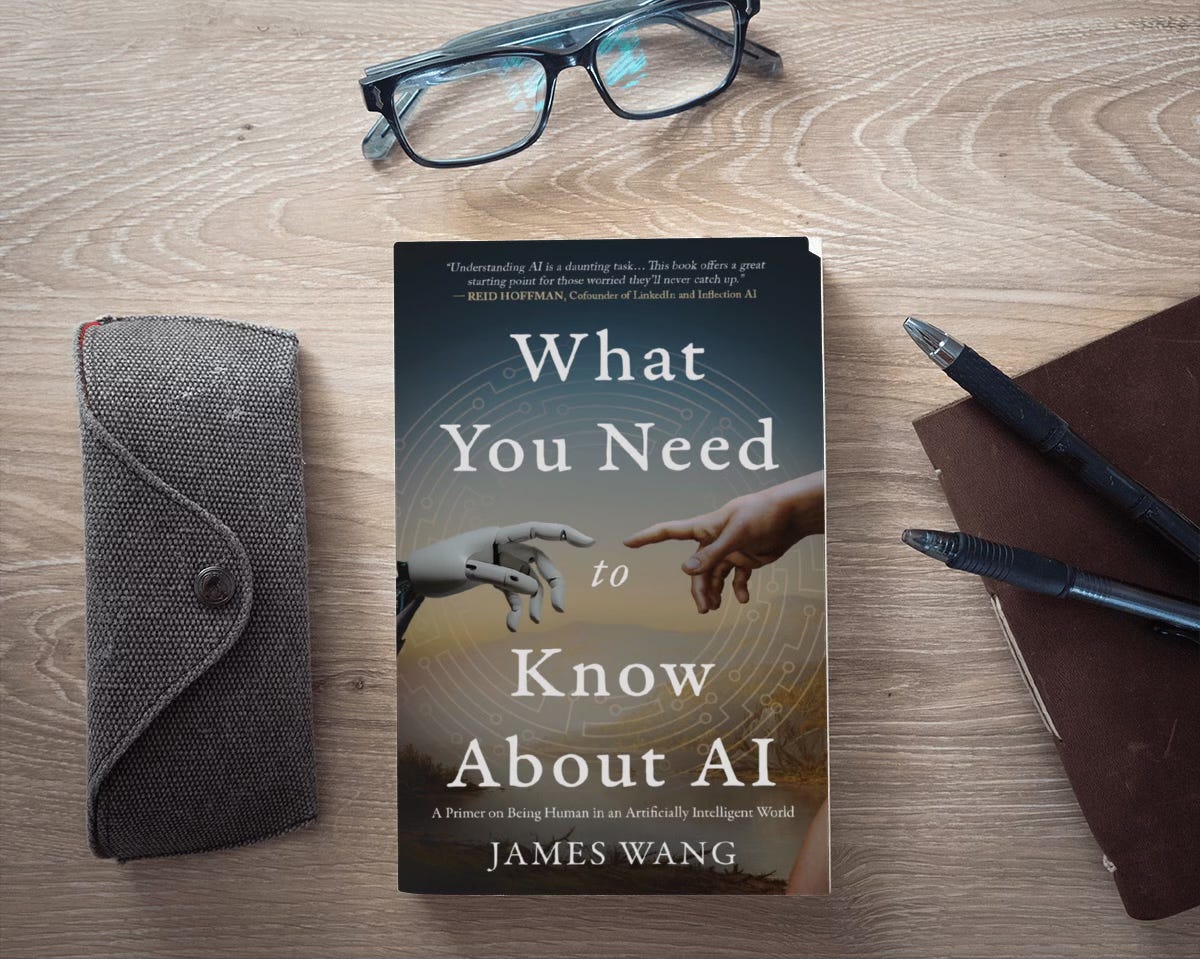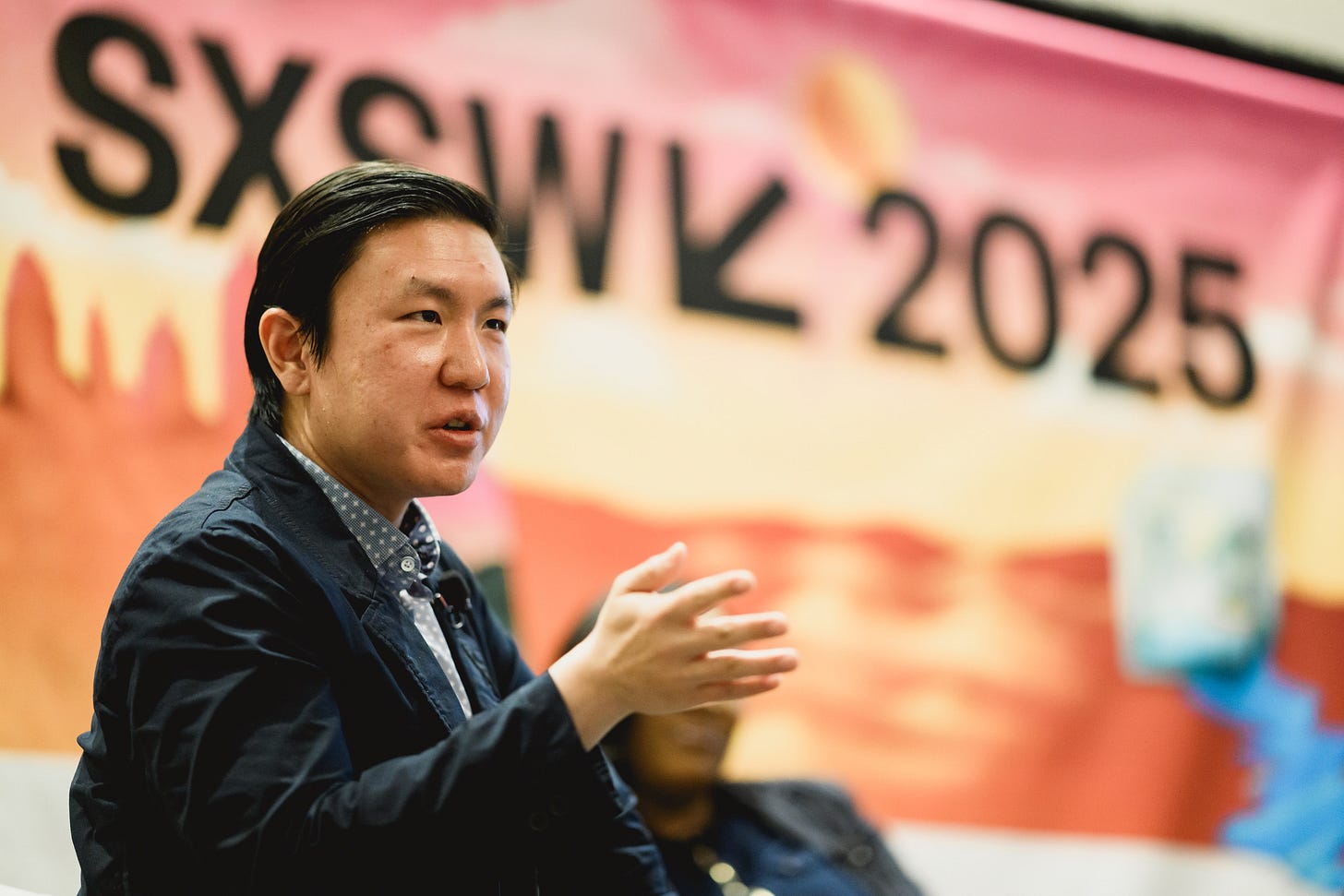What You Need to Know About AI
About the Book
What is AI, really—and how will we prepare for it?
Some say we should fear it. Others say worship it. But what’s real, what’s hype, and how will it actually impact our lives?
Whether you’re a total novice or simply want to round out your knowledge, this book is your one-stop crash course on AI. James Wang, former hedge fund investor at Bridgewater Associates, startup entrepreneur, and now deep tech venture capitalist, cuts through the hype with clarity and insight. He explains both AI’s true superpowers and its hard limits.
By the end, you will understand how AI is already transforming our world—and what is still to come.
Available October 15th, 2025
📘 Order on Amazon | Barnes & Noble | Bookshop (indie booksellers)
Want a sneak peek? Check out the introduction and first chapter here.
Early Praise
“Understanding AI is a daunting task that becomes more difficult with the advances each passing day. This book offers a great starting point for those worried they’ll never catch up. James covers the essential history, principles, and implications of AI in a way that is accessible to neophytes, but broad enough to offer useful insights even to AI professionals who often end up narrowly focused.”
- Reid Hoffman, Cofounder of LinkedIn, Partner at Greylock Partners, and Coauthor of New York Times Bestsellers The Start-up of You and The Alliance
“A masterclass for understanding and investing in the most transformative technology of our time. From AI history to hardware to hype, this book cuts through the noise and delivers signal with clarity and insight.”
- Rafic Makki, Head Technologist at Mubadala Ventures and former Executive Fellow at GlobalFoundries
“This is the book I will give to everyone in my life to help them get to grips with the future.”
- Jordan Schneider, Founder of ChinaTalk and Fellow at the Center for a New American Security (CNAS)
"James is one of the clearest thinkers in AI. This book is an encapsulation of everything that's excellent about his work—deep systems-level thinking delivered through deceptively clear prose. What You Need to Know About AI doesn't just tell you about AI; it gives you simple, powerful ways to understand its real impact on your job and the world. This is the most essential, grounded, and genuinely useful guide you will find on the most important technology of our time."
- Devansh, Head of AI at Iqidis, writer of Substack bestselling newsletter "Artificial Intelligence Made Simple."
"The quickest and clearest way I've seen to be well-informed on the most important topics in AI, and a book I will be sharing with friends that are trying to get up the curve on potentially the most important technology of our lifetimes."
- Josh Blanchfield, Chief Investment Officer at Avos Capital Management, Former Senior Executive at Bridgewater Associates
“James does a great job pulling back both the hype and horror around AI to paint a grounded but also encouraging picture of what the future can look like with this wide scope of exciting new technologies.”
- Dr. Joshua Reicher, CEO of IMVARIA, former clinical lead at Google’s medical AI group and faculty at Stanford Healthcare
“A lucid, deeply engaging exploration that demystifies the most consequential technology of our time. James brings together the rare trifecta of clarity, depth, and storytelling to deliver a guide on AI that is as thought-provoking as it is accessible. Essential reading for anyone who wants to understand what AI is and take an honest look at the implications of its integration into our lives. This book doesn’t just inform; it empowers. It’s the lighthouse for anyone navigating the fog of AI hype and fear.”
- Brandon Reed, Founder of Dwellspring and Host of the Ready, Set, Startup! Podcast
"James is a polymath bridging AI history, cutting-edge algorithms, and the AI revolution with philosophical depth and venture capital savvy."
- Sergei Polevikov, founder of WellAI, writer of Substack best-selling newsletter "AI Health Uncut", and author of “Advancing AI in Healthcare: A Comprehensive Review of Best Practices”
"Really enjoyed this book. James always asks penetrating questions and that translates into an excellent synthesis of the pitfalls and promises of the AI revolution."
- Alex Campbell, Founder and CEO of Rose.ai and former head of commodities at Bridgewater Associates
"I enjoyed reading this book by a successful and well-informed AI practitioner because it is easy to read and yet captures some of the tough issues at the dawn of the age of AI."
- Ashok Goel, Professor of Computer Science at Georgia Institute of Technology and Executive Director of the National AI Institute for Adult Learning and Online Education
📘 Order on Amazon | Barnes & Noble | Bookshop (indie booksellers)
Preview the introduction and first chapter here.
Author Bio
James Wang is a technologist, investor, and writer with over a decade of experience in AI and deep tech. He is a general partner at Creative Ventures, an early-stage deep tech fund backing breakthroughs in AI, synthetic biology, and advanced materials since 2016. Previously, he was on the investment team at Bridgewater Associates and worked at Google’s “moonshot” innovation lab, X.
James has served as a board director at startups working in AI, healthcare, and robotics and co-founded Lioness as CTO. He is a regular guest lecturer at UC Berkeley on entrepreneurship and startup financing. James holds a Master’s in Computer Science from Georgia Tech and an MBA from UC Berkeley Haas School of Business, where he was a Jack Larson Fellow in Entrepreneurship.
His Substack, Weighty Thoughts, is read by thousands of technologists, investors, and policymakers around the world—offering clear, insightful analysis at the intersection of AI, innovation, and society.
Can I get a sense of what else is in there?
Beyond the preview and the table of contents, yes, let’s go on a whirlwind tour of a few book excerpts:
From cultural basis in science function:
“It’s hard to make things inhuman because you’re always making things anthropomorphic, whether you like it or not. A human has no choice when they’re writing,” says Tom Toner during our call. He is an English science fiction writer and author of the Amaranthine Spectrum series, which features an AI as a core character...
To history:
In this case, it’s a story of two boys, both of whom went to the Bronx High School of Science in New York City, just a single grade apart. These two boys would grow up to shape the two great phases of AI before this one. Frank Rosenblatt, who we’ve already met. And Marvin Minsky, described as “the loyal opposition” by Rosenblatt, and who would fight Rosenblatt’s ideas throughout his life despite outliving Rosenblatt by almost five decades—and help bring about a multi-decade winter for the ideas that would eventually become modern neural networks.
To strategic:
Allen also shares on the podcast that the Department of Defense has been “drinking the AI Kool Aid and the autonomous systems Kool Aid really intensely since 2015.” But it was never significant. At least not before the Collaborative Combat Aircraft (CCA) contract—literally, an AI “wingman” for human pilots—was awarded to Anduril and General Atomics in April 2024. Note, not the typical defense contractors like Lockheed and Boeing, who the tech company, Anduril beat.
To technical:
Convolutional neural networks like AlexNet accomplish this by taking many small, overlapping snapshots all over the image (to solve image shifts or mirroring), applying a filter to recognize features (“things”) inside of each tiny snapshot, and then handing the entire thing into the “classic” black-box connected neural network. This is how AI tells the difference between humans, bridges, cars, and cats.
To the future:
We will also need better cooling. We’re already seeing fascinating progress in “sci-fi” technologies like immersion cooling—where entire racks or even data centers are submerged in liquid. Or even take some of that heat and siphon it off into thermal batteries, which can either be turned back into electricity… or simply be used to make steel or other products. After all, 20% of global energy demand is actually just to make heat and we could “recycle” some of it.
Please share!
Even if you want to wait, I’d love for you to share and get the word about the book out—whether or not those friends want to pick it up in stores, or if they want a fancy signed copy!
📘 Order on Amazon | Barnes & Noble | Bookshop (indie booksellers)
Preview the introduction and first chapter here.



